Causes of pale green cucumber leaves and methods of dealing with the problem
In healthy, properly developing cucumber lashes, the foliage is bright green in color. But their appearance can change under the influence of various factors. Blanching or yellowing of the leaves is a reason to urgently take measures to save the crop from possible rotting.
The content of the article
The reasons that cucumber leaves are pale green
The color change can occur both on the entire surface of the sheet, and along the edges or in the form of separate spots. Also, the plate may have prominent bright streaks and a pale space between them.
Having found the first signs of a problem, carefully examine the cucumbers. With these symptoms, the plant can throw off all ovaries. Let's consider the most common reasons.
Lack of micro- and macronutrients
The imbalance of nutrients leads to the loss of the cucumbers of their presentation and deformation of the fruit. Nitrogen is responsible for foliage pigmentation - its deficiency affects not only the color, but also the development of young seedlings, the formation of lateral lashes.
Reference. The lack of nitrogenous fertilizers is determined by the following signs: the leaf becomes paler, then turns yellow, and all the veins remain bright and discolored just before falling off.
But in some cases, even a sufficient amount of nitrogen in the soil is not a guarantee of normal growth of cucumbers. If the root system is poorly developed in the tops, it does not assimilate nutrients in the required amount, so you will have to look further for the exact reason.
The most important substances for cucumbers and other fertilizers:
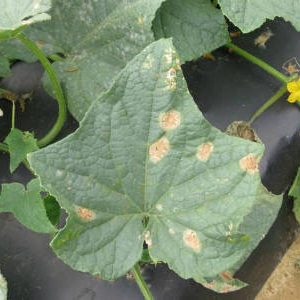
- Calcium. Adult leaves do not react to its lack, and young leaves do not develop to a large size and look unnaturally bright at first and become pale gradually, discoloring from the center to the edge in stripes.
- Copper. The tops become pale green, while the plant slowly fades, which indicates a lack of this element.
- Potassium. Its deficiency is manifested by pallor and further acquisition of brown tops. If there is an excess of peat in the soil, the plant will quickly and completely die.
- Phosphorus. The development of the bush stops, it does not stretch up, the leaves become pale yellow and hard to the touch, fall off after a few days.
An excess of fertilizers is also contraindicated for cucumbers. For example, when they are excessively sprayed with Bordeaux liquid and excess boron, mature leaves begin to fade and turn yellow at the edges. Then colorless spots spread throughout the plate, the leaf wrinkles and falls off.
With iron deficiency, young leaves turn pale and yellow first, then the problem spreads to the entire bush. If you don't make feeding, the crop dies completely.
Diseases
A common cause of pale tops is infection and pest attacks. The plant becomes vulnerable to disease if the air temperature drops below + 15 ° C, and the soil is excessively moist.
Gardeners most often face the following diseases: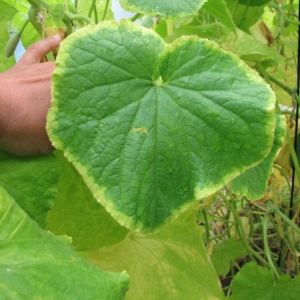
- fusarium - affects the root part and the vascular system, the greens become watery and lose color;
- peronosporosis (downy mildew) - a bloom forms on the leaf plates, but not white, but yellowish-grayish, over time they turn yellow and dry out (the reason is excessive watering or temperature fluctuations);
- anthracnose - manifested by the pallor of individual sections of the plates, and then the formation of brown spots in their place;
- angular spotting - the leaves become discolored, holes form on them, a pinkish liquid appears (the fruits become deformed with brown ulcers).
If the bushes are attacked by pests, then urgent agrotechnical measures will be required. The introduction of special chemical compositions will help the correct development of the lashes and increase the resistance of the crop to damage.
Unwanted guests on the site are spider mites, whiteflies and melon aphids.
Agrotechnical errors
Inexperienced summer residents are sure that the more ovaries remain on the bush, the richer the harvest will be. This is one of the biggest mistakes... For optimal load and sufficient saturation with nutrients, it is necessary to leave no more than 20 ovaries, otherwise the lash will turn pale due to lack of vitality.
The reason for the color change is insufficient pollination of plants. This problem is more often faced by the owners of greenhouses, where insects do not get access to cucumbers. They must be attracted by planting melliferous plants in the greenhouse. But you should beware of the May beetle: it will destroy the entire crop with lightning speed.
Important! The plant reacts sharply to watering with cold water. It is recommended to use only warm water, about the same temperature.
Frost
Temperature fluctuations and night frosts are categorically contraindicated for plants. Such changes cause the foliage to turn pale, and then the ovaries are shed. In addition, with persistently cloudy weather, the process of photosynthesis is disrupted, the brightness of the tops disappears. But as soon as sunny days return, healthy bushes acquire a natural bright green color.
Why do cucumber seedlings have pale green leaves
Young specimens sometimes lose their bright color, and active growth stops. First, you need to identify the cause of this problem, and then proceed to fix it: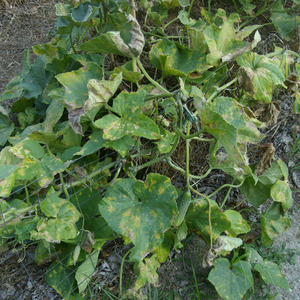
- too early planting in an open area (the soil has not yet warmed up enough, all the foliage can not only lighten, but also completely crumble);
- excess organic top dressing (temporarily suspend the introduction of chicken manure, replace it with bread or ash solutions);
- lack of moisture and watering with cold water (young roots freeze through);
- too many ovaries (young formations quickly draw out all the forces from the plant, the seedlings become lethargic and lose color).
Diseases can also affect cucumber seedlings: mosaic disease, powdery mildew, root rot. The affected parts of the plant must be identified and destroyed in a timely manner, since the spread of infection and fungal infections occurs quickly.
Is it dangerous for the harvest
When developed correctly, cucumbers should have bright green leaves. Their paleness is an alarming signal, which suggests that the crop may be threatened with complete destruction.
Any deviation is fraught with negative consequences, negatively affects the vegetative process. On bushes affected by diseases, the fruits become unusable.
What to do
The crop must be saved promptly, having correctly identified the cause of the blanching of the tops. First of all, you must follow the rules of timely fertilization:
- the first feeding - 14 days after planting young seedlings in an open area;
- the second - with the beginning of flowering;
- the third - during the fruiting period;
- the fourth - 20 days after the previous one;
- the fifth is required only for depleted soil.
Plants should be examined for pests, and Actellic or other means of protection should be used to destroy them.
Important! Treatment with insecticides and any chemicals should not be carried out later than three weeks before harvest.
How to feed cucumbers
To restore the balance of nutrients, vegetables are fed with any available means:
- 1 liter of mullein is diluted in 10 liters of water and the bushes are watered gently to the very root;
- weeds are crushed and bred in a 1: 5 ratio with water, infused for 10 hours and watered;
- 1 tbsp. l. urea dissolved in 10 liters of water;
- 200-250 g ash on a ten-liter bucket of water (1 liter for each bush);
- 1 pack of fresh yeast per 10 liters of water (a rich source of iron, manganese, phosphorus, potassium, nitrogen).
An effective complex feeding for cucumbers is chicken droppings, you can use fresh or rotted ones (diluted with water in a ratio of 1:10). 700-800 ml of infusion is enough for one bush. To bring in such top dressing, in the morning, the beds need to be watered - to prevent burning the roots.
Preventive measures to prevent the problem
In order to prevent the tops from wilting and discoloration, it is recommended to observe the following measures:
- Feed the plants regularly, every 15 days, applying fertilizers only in the evening and not exceeding the dosage indicated by the manufacturer on the package.
- Observe the crop rotation (you cannot plant cucumbers on the same plot for more than two years in a row).
- Water regularly and use only lukewarm water.
- Mulch the soil with cut grass or weeds to prevent rapid evaporation of moisture.
- Control the humidity in the greenhouse.
- Attract insects to greenhouses for natural pollination (plant dill, melliferous herbs nearby or spray the plantings with boric acid from a spray bottle).
- Remove excess ovaries, leaving no more than 20 pieces per bush.
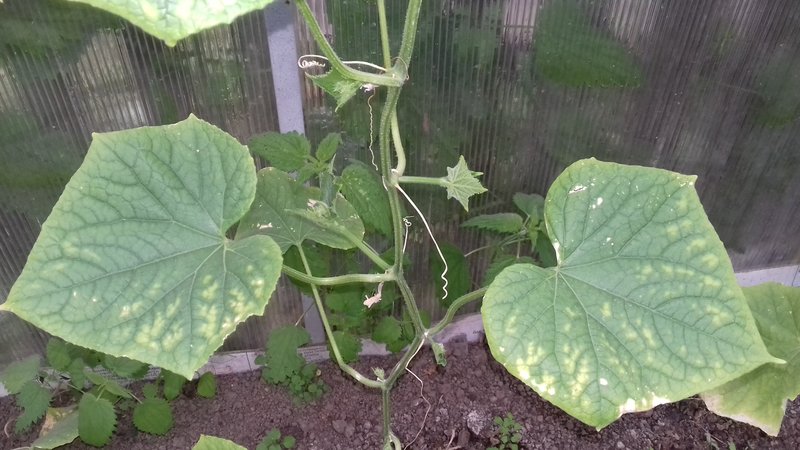
Plants must be treated with a prophylactic solution immediately after the first shoots appear, which will strengthen their immune system and protect them from pests. To do this, use the following composition:
- 20 g of laundry soap;
- 30 drops of iodine;
- 1 liter of milk.
Young seedlings are sprayed with the solution 15 days after germination.
Important! The cucumber is a moisture-loving plant, therefore, delay or insufficient watering is detrimental to it.
Tips from experienced gardeners
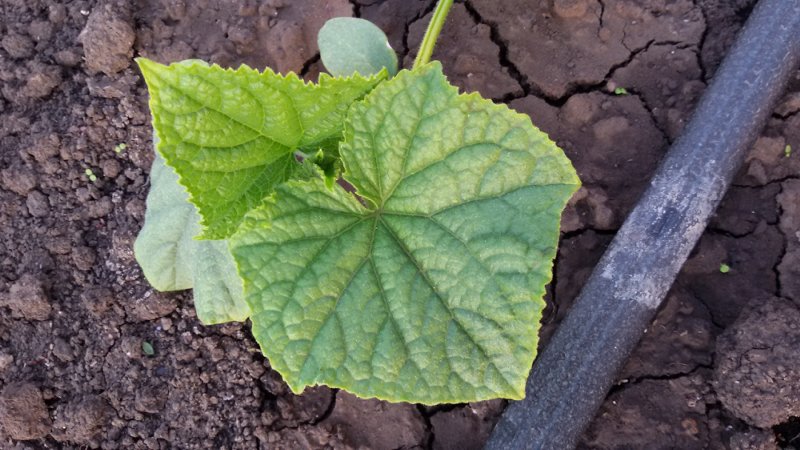
How to protect the crop from death and prevent the leaves from turning pale? For those who plant seedlings in a greenhouse, the key to success is preliminary cleaning in the greenhouse before the planting season. It is necessary to remove all old foliage, wash and disinfect the walls with a solution of potassium permanganate.
Despite the high effectiveness of folk recipes for feeding cucumbers, it is recommended to use professional tools. These are balanced formulations that can cost more, but have a beneficial effect on the development of vegetables.
For example, "Magbor", "Calcinite", "Uniflor", "Omeks", "Molybion" are produced with the content of individual microelements.
Reference. For emergency replenishment, you can use two-component formulations - "Azophos" and "Diammophos" (phosphorus with nitrogen) or three-component - "Nitrofosku" (nitrogen, phosphorus and potassium).
Summer residents recommend using a simple method to determine an alkaline soil in which phosphorus is poorly absorbed: for this, check the reaction with litmus paper. If you get positive results, add peat or sawdust to the soil.
An important rule of cucumber care is regular processing and disinfection of garden tools. For example, mosaic can damage even seeds, and its activity persists for about three years.
Conclusion
By the discolored leaves, you can tell that something is wrong with the plant. The sooner the problem is detected and diagnosed, the more effective will be its elimination. The task of every gardener is prevention, timely diagnosis and proper care of the crop. The reward for the efforts will be a high-quality and rich harvest.